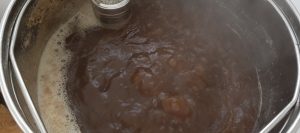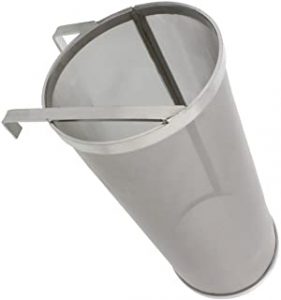Boiling
 Once the sparge is complete then it’s time to get the boil underway. The boil kettle, or copper as it is sometimes known, must have a powerful heat source to produce a strong rolling boil. Boiling brings about a host of chemical changes. As well as halting the enzyme action from the mash, it also sterilizes any unwanted bugs in the wort, removes certain volatile compounds that could otherwise cause off flavours, isomerizes the alpha acids from the hops, and reduces the volume of the wort (thereby concentrating it). Shortly after the hot wort is brought to the boil, a thick scum will form on the surface. This is known as the ‘hot break’ and is caused by proteins from the grains sticking together. This should be carefully skimmed off and discarded. The wort is usually boiled for 60 to 90 minutes.
Once the sparge is complete then it’s time to get the boil underway. The boil kettle, or copper as it is sometimes known, must have a powerful heat source to produce a strong rolling boil. Boiling brings about a host of chemical changes. As well as halting the enzyme action from the mash, it also sterilizes any unwanted bugs in the wort, removes certain volatile compounds that could otherwise cause off flavours, isomerizes the alpha acids from the hops, and reduces the volume of the wort (thereby concentrating it). Shortly after the hot wort is brought to the boil, a thick scum will form on the surface. This is known as the ‘hot break’ and is caused by proteins from the grains sticking together. This should be carefully skimmed off and discarded. The wort is usually boiled for 60 to 90 minutes.
I use an open top hop basket during the boil. This makes it very easy to add the hops at the various stages required by the recipe:
- ‘First Wort Hopping’ (FWH) – this is when a large portion of the hops is added to the boil kettle as the wort is transferred from the mash tun ready for sparging.
- ‘Bittering hops’ are added at the beginning of the boil – these will achieve the most bitterness, but also lose the most of their aromatic essential oils. Bittering hops are left to bubble and steep for at least 45 minutes and up to an hour and a half. The heat catalyses a chemical reaction called isomerization, which turns alpha acids into water soluble iso-alpha acids. The longer bittering hops are left to boil, the more iso-alpha acids are transferred to the wort. However, a long boil destroys the flavourful essential oils inherent to hops
- ‘Flavour hops’ are added midway through the boil. The use of flavour hops allows for those delicate essential oils to be preserved, so they are boiled for a shorter duration – generally about 15 minutes but no more than about 30.
- ‘Aroma hops’ (or ‘finishing hops’): the essential oils in hops responsible for aroma are even more susceptible to the damaging effects of heat. For that reason, aroma hops are added at the very end and boiled for the shortest amount of time – typically not longer than five minutes. Aroma hops therefore add little or no bitterness.
- Hops may also be added after the boil is complete – these are known as ‘flame out’ hops. Once again, these are added purely for their aroma, and impart little or no bitterness.
- ‘Whirlpool’ hops are added after the wort is part-cooled after the boil is complete (down to about 70 – 80 °C). A mash paddle or large spoon is used to stir the wort, until a whirlpool is established. Then the whirlpool hops are added. Stirring is continued for a few minutes, then the wort is allowed to settle, at the required whirlpool temperature, for 10 – 20 minutes. Whirlpool hops don’t add much to the bitterness, but do enhance the aroma.
- ‘Dry hopping’ refers to the extraction of the volatile oils slowly and gently over a period of days or even weeks. Dry hops, which are added to the fermenter or keg, are commonly used in the production of Pale Ales and IPAs.
Copper finings may be added at the end of the boil, to improve the clarity of the wort. Originally, unprocessed seaweed of the species Chondrus crispus (Irish Moss) was used to good effect. Today, it is the carrageenan, extracted from Irish Moss, that is mostly used in brewing. Its role as the most cost-effective method of wort clarification is undisputed. I use Britewort tablets (which contain carrageenan).
